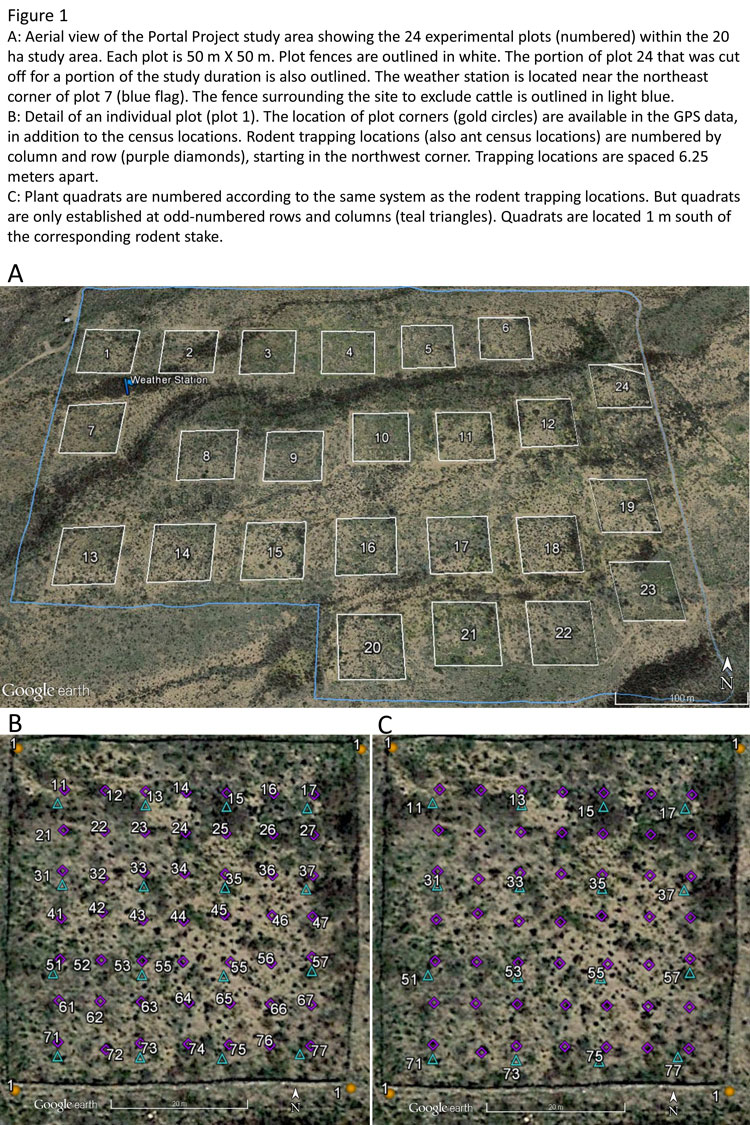Rodent Survey Data Overview
Adapted from the Portal Data README
Portal Rodent Monitoring Metadata
Abstract
The data set includes continuing monthly rodent surveys. Each month rodents are trapped on all 24 experimental plots and information on each captured rodent is contained in this file. The data set should prove useful for studying population dynamics and species interactions. Sampling is ongoing and data will be added over time.
Site description
Within the 20 ha study area there are 24 experimental plots. Each plot has an area of 0.25 ha and is fenced to regulate rodent access to the plot. Access is regulated using gates cut into the fencing. Large gates (3.7 x 5.7 cm) allow all small mammals to access plots. Small gates (1.9 x 1.9 cm) exclude kangaroo rats (Dipodomys) whose inflated auditory bullae make their skulls too large to pass through the gates. Rodent removal plots do not contain any gates and animals caught on those plots are removed and released outside the cattle exclosure fence.
On each plot there are 49 permanent trapping stations marked by rebar stakes forming a 7x7 grid. Every stake on a plot has a unique identifying number denoting the coordinate of that stake on that plot. Rows are numbered 1 through 7 going from the most northern row to the most southern. Columns are numbered 1 through 7 going from the most western column to the most eastern. For example, stake 73 is the third stake on the final (seventh) row (see Portal Overview Metadata, Fig 1). Starting in 2005, stakes 16 and 17 no longer exist in plot 24, due to changes to plot shape. In 2016, the corner of Plot 24 was rebuilt, and trapping resumed at those stakes.

Portal Overview Metadata, Fig 1
Treatments
See Portal Overview Metadata, Table 2, for details on treatment assignments for each plot. See the latest (link at top) and previous data publications (Ernest et al 2009) for a history of plot treatments and methods.
Data Collection
From 1977-present, plots were trapped around each new moon - which occurs approximately once a month, though occasionally blue moons do occur, resulting in 2 separate surveys in a month. Occasionally, months are missed. Months that are entirely missed are not noted in the database. Sometimes weather or other unforeseen occurrences prevent the complete trapping of a survey, these are noted in the database. Due to intermittent funding, gaps in data collection exist beginning in 2010.
The site is surveyed for rodents approximately once each month. The survey occurs as close to the new moon as possible to minimize external effects on trapping success which could be misconstrued as actual changes in populations. During a survey, each plot is trapped for one night with treatments divided evenly between nights to eliminate differences between controls and treatments caused by environmental differences on different nights. When a plot is surveyed, all gates are closed to ensure that only resident individuals are captured. At each stake, one Sherman live-trap is placed and baited with millet seed. Traps are collected the next morning and individuals processed.
Any animal found in a trap is recorded. Non-rodent species are occasionally trapped and so are given species codes. Several flags are included in the species table to restrict the species list to only rodents, only target species, or only granivores. Additionally, the Note2 column in the rodent data table contains a flag for non-target species (=13).
Each individual of a target species is tagged and data on species, location caught (plot and stake), sex, reproductive condition, weight, and hindfoot length are recorded. It is noted in the database if either an animal escaped before all information was gathered, was removed from the site because it was caught on a plot it was supposed to be excluded from, or died during trapping.
Data Carpentry, 2017.
License. Questions? Feedback?
Please file
an issue on GitHub.
On Twitter: @datacarpentry